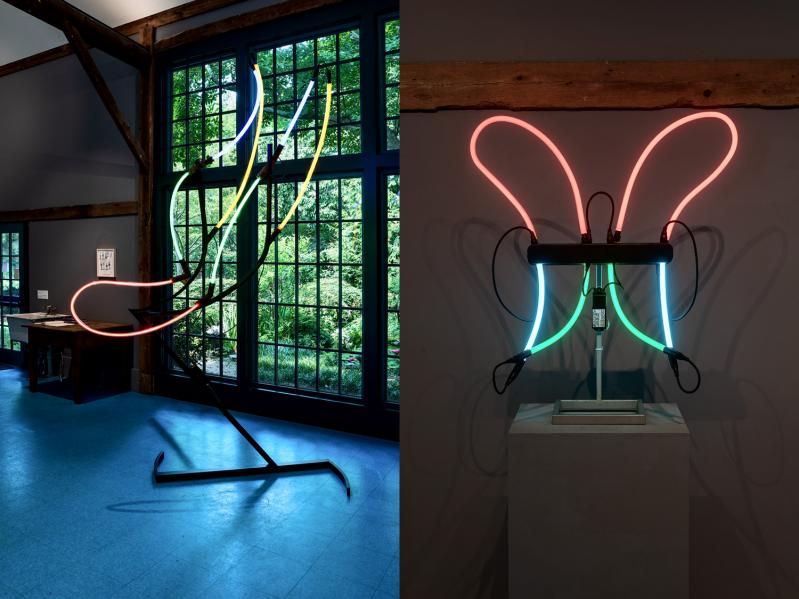It's hard to believe that there are only two more days to see "Keith Sonnier: Selections From the Herd Series," an installation at Sagaponack's Madoo Conservancy. It has been up since mid-July, but that is the kind of whirlwind summer we have had this year.
Friday and Saturday remain for seeing these artful interpretations -- neon drawings in air as well as drawings on paper -- of herd animals inspired by Sonnier's travels and the American Museum of Natural History in New York City.
According to Madoo, he embarked on the series from 2006 to 2008 after viewing relics of mastodons and photos and dioramas of other herd animals in the museum. The series was also influenced by places he had seen such as India, the Far East, and Brazil, underlining the artist's interest in other cultures and anthropology. The three sculptures and 10 drawings on view offer a window into his process as he perceived reality and reduced it down to his own visual language and marks.
These are works that were executed when Sonnier, who died in 2020, was in his mid-60s. They show evidence of his curious eye and ability to find continual inspiration in the world around him after a lifetime of working in the same material. Seeing the progression from his more geometric abstractions to these referential works -- evoking gazelles, antelopes, buffalo, elephants, and birds -- is fascinating and illuminating.
An antelope study from 2007 is included to help illustrate how the artist begins his process of abstraction, paring the images down to their essence. Two other studies show how those abstractions are further reduced, not just to a linear framework, but reanimated into graceful curves that will eventually become tubing to hold colored neon gas, the medium he had been using for 40 years at that point.
The later antelope studies are named for the eventual finished sculpture they would become. "Kgama" means antelope in Bantu. The finished sculpture is also on view here in the summer studio. It has pride of place in the room, in front of the floor-to-ceiling windows on the wall facing the pond and bridge.
This is fortunate placement, because the sculpture's bright primary colors echo the painted colors of the elements on the bridge and its seating, as well as the vibrant greens of the garden and the electric blue summer skies of the South Fork in midday. It makes a strong visual argument for including the pieces in a studio that held quite different art with the work of Robert Dash, the founder, builder, and occupant of Madoo until his death in 2013.
Sonnier was a neighbor of Dash's and a member and frequent visitor to Madoo. No doubt he was affected by looking at the same vistas, sky, and landscape. As different as Sonnier's oeuvre is from Dash's, having Sonnier's pieces occupy Dash's former studio shows how each artist took liberties with observed phenomena, working over subjects until they could seem unrecognizable from their original source material, yet still hold some essence.
There are two other neon sculptures, "Wildebeest," which is in the center of the exhibition in the middle near the front wall, and "Mastodon," closest to the front door. "Wildebeest" has been reduced to a pair of abstracted horns, flattened to the point where they almost represent a butterfly's wings, even as the sharp ends point downward in a somewhat threatening way.
"Mastodon" looks abstract and specific at the same time. Given the prehistoric nature of the animal depicted, it already has an air of unknowability. In Sonnier's hands, the creature, which in typical renderings looks like an elephant with some boar added in, is reduced to what might be his head and a single long horn. It's a geometric abstraction with an organic source, and the blending is seamless.
As in "Kgama," the other drawings offer clues to the artist's working process, taking something observed and translating it into loose and idiosyncratic lines and shapes, not only pliable in neon, but reflecting how his mind interpreted these very specific creatures. They are important documentary works that also stand on their own. However, the neon, as always, steals the show, whether the exhibition is viewed inside the room or seen from the outside into the space.
Gallery hours are noon to 4 p.m., and advance registration on the website is encouraged.




